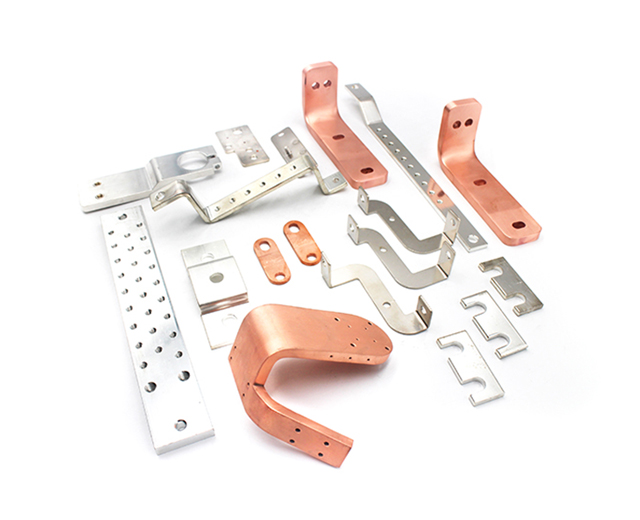

A Busbar (also called an Electrical Bus Bar or Mother Bar) is a highly efficient metal conductor used to distribute and transfer electrical power within power systems. Unlike round cables, a busbar is typically designed as a flat, wide, and thick metal bar, allowing it to carry high current with lower resistance and better heat dissipation.
In modern power distribution systems, busbars are widely used in switchgear, electrical panels, energy storage systems, renewable power stations, industrial equipment, and EV battery packs.

A busbar is used to:
Distribute electrical power between multiple circuits or devices
Reduce energy loss and improve current flow efficiency
Simplify wiring layout and shorten power transmission paths
Provide stable and safe high-current conduction
The main functions include:
Conducting and distributing high current
Reducing heat and resistance
Providing mechanical connection points for cables and components
Enhancing system safety and reliability
This structure forms a Busbar System, which ensures efficient and stable power transmission.
Copper is known for its excellent electrical conductivity and mechanical strength.
Solid Copper Busbar: rigid, stable, suitable for switchboards and transformers
Flexible Copper Busbar: made from braided or laminated copper, suitable for vibration and space-limited environments
Surface Finishing Available: Tin-plated, Nickel-plated, Silver-plated for anti-oxidation and lower contact resistance
Aluminum busbars are:
Lighter in weight
More cost-effective
Suitable for large-scale power systems and distribution cabinets
For compact and modular applications (e.g., UPS, ESS, EV), providing:
High insulation strength
Low inductance
Space-saving integrated design
| Type | Structure | Features | Applications |
|---|---|---|---|
| Solid Busbar | Rigid flat bar | High strength and durability | Power cabinets, substations |
| Flexible Busbar | Braided or laminated | Absorbs vibration, bendable | Battery packs, EV, ESS |
| Flexible Copper Busbar | Pure copper layers | High conductivity, flexible | Renewable systems, low voltage |
| Flexible Aluminum Busbar | Aluminum layers | Lightweight & economical | Large distribution systems |
Busbars are widely used in:
Power Distribution Cabinets & Switchgear
UPS & Data Centers
Energy Storage System (ESS) Cabinets
Solar Inverters and Renewable Energy
EV Battery Packs and BMS Systems
Industrial Machinery & Automation Equipment
| Advantage | Description |
|---|---|
| Direct Factory Supply | OEM / ODM custom manufacturing available |
| Material Selection | Pure Copper T2 / C1100, Aluminum 1060/6061 optional |
| Custom Processing | Bending, punching, plating, welding, insulation coating |
| Surface Treatment | Tin plating / Nickel plating / Silver plating / Epoxy insulation |
| Precision Quality Control | 100% inspection for conductivity, dimensions, and surface finish |
We support Custom Busbar Design based on customer drawings or technical requirements.
Provide Drawing / Current Rating / Application Scenario
Choose Copper or Aluminum
Confirm Plating and Insulation Options
We offer quotation + sample + mass production
Q1: What is a busbar?
A busbar is a metallic conductor used to collect and distribute electrical power within power systems. It is typically made of copper or aluminum and provides a low-resistance path to conduct large currents efficiently.
Q2: What is a busbar used for?
A busbar is used for power distribution in electrical panels, switchgear, substations, UPS systems, industrial equipment, and renewable energy systems. It ensures stable power transfer between different circuits.
Q3: What is the function of a busbar in a power system?
The main function of a busbar is to transfer large current from incoming feeders to outgoing circuits while minimizing energy loss. It also improves safety, reduces wiring complexity, and enhances system reliability.
Q4: What does a busbar look like?
A busbar usually appears as a flat, wide, thick metal strip or bar, not a cable. It may have holes at the ends for bolted connections and comes in various thicknesses depending on current requirements.
Q5: What materials are commonly used for busbars?
Busbars are mainly made from:
Copper (high conductivity, excellent performance)
Aluminum (lightweight, cost-effective)
Q6: What is the difference between a copper busbar and an aluminum busbar?
| Item | Copper Busbar | Aluminum Busbar |
|---|---|---|
| Conductivity | Higher | Lower |
| Weight | Heavier | Lighter |
| Price | Higher | More economical |
| Applications | High-end and heavy-duty systems | General and lightweight installations |
Q7: What is a solid busbar?
A solid busbar is a rigid bar made from solid copper or aluminum, used in switchboards, distribution panels, and heavy-duty equipment where stable mechanical support and high current capacity are needed.
Q8: What is a flexible busbar?
A flexible busbar is made from layered copper or aluminum foils or braided strips. It is used where vibration absorption or flexible installation is required, such as in batteries, inverters, and EV systems.